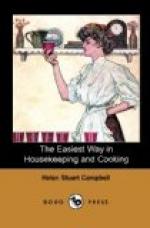As old age advances, the food-demand lessens naturally. Nourishing food is still necessary, but taken in much smaller quantities and more often, in order that the waning powers of the stomach may not be overtaxed. Living on such principles, work can go on till the time for work is over, and the long sleep comes as quietly as to a tired child. Simple common-sense and self-control will free one once for all from the fear, too often hanging over middle life, of a paralytic and helpless invalidism, or the long train of apoplectic symptoms often the portion even of middle life.
I omit detail as to the character and effects of tea, coffee, alcohol, &c, such details coming in the chapters on the chemistry of food.
CHAPTER X.
THE CHEMISTRY OF ANIMAL FOOD.
Animal food has a wider range than is usually included under that head. The vegetarian who announces that no animal food is allowed upon his table offers a meal in which one finds milk, eggs, butter, and cheese,—all forms of animal food, and all strongly nourishing. A genuine vegetarian, if consistent, would be forced to reject all of these; and it has already been attempted in several large water-cures by enthusiasts who have laid aside their common-sense, and resigned with it some of the most essential forces for life and work. Meat may often be entirely renounced, or eaten only at rare intervals, with great advantage to health and working power, but the dietary for the varied nourishment which seems demanded must include butter, cheese, eggs, and milk.
Meats will be regarded as essential by the majority, and naturally they come first in considering food; and beef is taken as the standard, being identical in composition with the structures of the human body.
BEEF, if properly fed, is in perfection at seven years old. It should then be a light red on the cut surface, a darker red near the bone, and slightly marbled with fat. Beef contains, in a hundred parts, nearly twenty of nitrogen, seventy-two of water, four of fat, and the remainder in salts of various descriptions. The poorer the quality of the beef, the more it will waste in cooking; and its appearance before cooking is also very different from that of the first quality, which, though looking moist, leaves no stain upon the hand. In poor beef, the watery part seems to separate from the rest, which lies in a pool of serous bloody fluid. The gravy from such beef is pale and poor in flavor; while the fat, which in healthy beef is firm and of a delicate yellow, in the inferior quality is dark yellow and of rank smell and taste. Beef is firmer in texture and more satisfying to the stomach than any other form of meat, and is usually considered more strengthening.
MUTTON is a trifle more digestible, however. A healthy person would not notice this, the digestive power in health being more than is necessary for the ordinary meal; but the dyspeptic will soon find that mutton gives his stomach less work. Its composition is very nearly the same as that of beef; and both when cooked, either by roasting or boiling, lose about a third of their substance, and come to us with twenty-seven parts of nitrogen, fifteen of fat, fifty-four of water, and three of salty matters.




